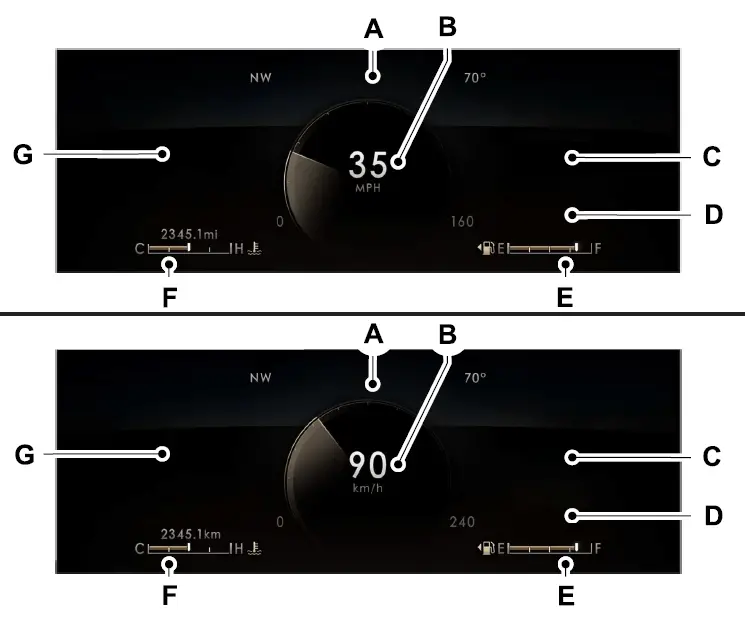2024 Lincoln Aviator Instrument Cluster Owner’s Manual
To understand the 2024 Lincoln Aviator’s gauges, indicators, and touchscreen displays, examine its instrument cluster arrangement. Read speed, fuel levels, system alarms, and infotainment data with confidence with this guide, improving your driving awareness, safety, and luxury.
2023 – 2024 LINCOLN Aviator Specs, Price, Features, Mileage and Review
Video: 2024 Lincoln Aviator Dashboard Warning Indicators
Instrument Cluster
GAUGES

- Status bar.
- Speedometer.
- Information on demand.
- Vehicle range display.
- Fuel and battery gauges.
- Engine coolant temperature gauge.
- Tachometer.
Note: Clusters are shown in single gauge view.
Note: Displays may appear slightly different depending on region.
Status Bar
Displays information related to the current audio source, compass direction and outside air temperature.
Information On Demand
Displays selected on-demand information screens.
Fuel Gauge
The fuel gauge indicates approximately how much fuel is in the fuel tank. The arrow next to the fuel pump symbol indicates on which side of your vehicle the fuel filler door is located.
Note: The fuel gauge may vary slightly when your vehicle is moving or on a slope.
Low Fuel Reminder
A low fuel reminder displays and sounds when the distance to empty reaches 50 mi (80 km), 25 mi (40 km), 10 mi (20 km) and 0 mi (0 km).
Note: The low fuel reminder can appear at different fuel gauge positions depending on fuel economy conditions. This variation is normal.
Battery Gauge
The high-voltage battery gauge displays the total amount of charge associated with your available electric-only driving range. A full fill represents the total amount of energy you can get from an external charge by plugging your vehicle in. When the fill reaches empty the powertrain system switches to hybrid operation.
Vehicle Range Display
Displays the approximate range your vehicle can travel with the energy currently onboard. Estimates vary based on the energy used when driving. Changes in driving pattern can cause the values to not only decrease but also increase or stay constant for periods of time.
The amount of energy being used when driving is affected by:
- Mild or aggressive acceleration or braking.
- Vehicle speed.
- Use of accessories, such as climate control.
- Ambient temperature and other weather conditions.
- Driving in a city or on a highway.
- Driving on flat or hilly roads.
- Towing.
Note: It is normal for vehicle range estimates to vary due to changes in average energy usage. This is why you see different range estimates each time you fill up the fuel tank or fully charge the battery.
Note: Electric range is lower in cold temperatures due to reduced energy capacity in the high voltage battery. Set a departure time and cabin temperature to maintain battery temperature for best range and performance.
Gasoline Distance to Empty
Indicates the approximate distance your vehicle can travel on the fuel remaining in the tank.
Electric Range
Indicates the approximate distance your vehicle can travel on electric power only with the engine off.
Engine Coolant Temperature Gauge
WARNING: Do not remove the coolant reservoir cap when the engine is on or the cooling system is hot. Wait 10 minutes for the cooling system to cool down. Cover the coolant reservoir cap with a thick cloth to prevent the possibility of scalding and slowly remove the cap. Failure to follow this instruction could result in personal injury.
Indicates the engine coolant temperature. At normal operating temperature, the level indicator is in the normal range. If the engine coolant temperature exceeds the normal range, stop your vehicle as soon as safely possible, switch off the engine and let the engine cool.
Useful Links
2023 – 2024 LINCOLN Aviator Specs, Price, Features, Mileage and Review
2024 Lincoln Aviator Warning Lights and Indicator Guide
2023 – 2024 LINCOLN Aviator Specs, Price, Features, Mileage and Review


